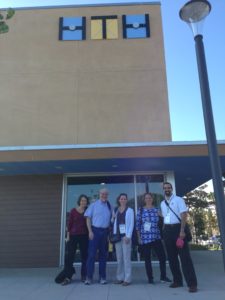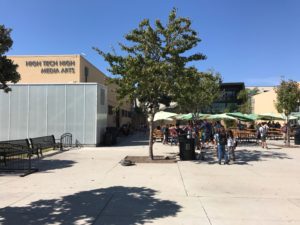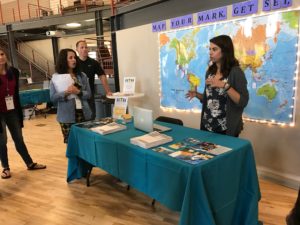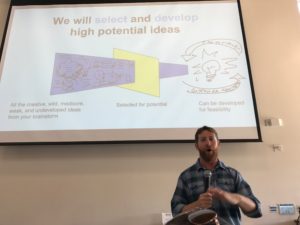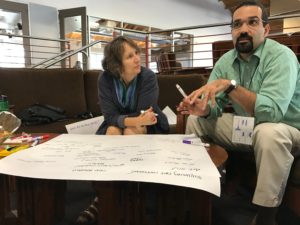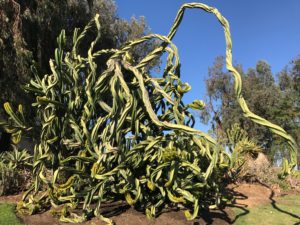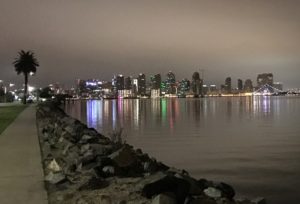This past week, I spent three days visiting High Tech High in San Diego with four other teachers and administrators from Lincoln Sudbury RHS. Our high school is in the early stages of building an Innovation Center, and we are looking for good ideas wherever we can find them. Our trip was supported by a Title I educational grant and by the Sudbury Educational Resource Fund (SERF). High Tech High prides itself on its innovative faculty and the way they use Project Based Learning to engage their students in authentic experiences.
High Tech High
High Tech High is a public charter school in San Diego. It is not just a high school – it’s a campus with three separate high schools, several middle and elementary schools, and a graduate school of education, which organized our program. The campus is spread out through several blocks in the Fort Liberty section of San Diego.
High Tech High prides itself on using Project Based Learning (PBL) as the cornerstone of its curriculum. Teachers develop projects for their own classes with a high degree of autonomy. At the high school level (I focused my observations on the high schools) students take two classes per day, each of which meets for about two hours. In addition students have an hour of math each day, a community meeting and an advisory block each once a week, and an “x-block” twice a week for activities and small, interest based classes.
The halls of the high schools I visited were covered with the deliverables of student projects. I saw math projects, art projects, english projects and social science projects all displayed in one small area of the building. In one chemistry class, alongside more traditional activities, students make, package and sell bars of soap. It was the nicest smelling high school classroom I’d ever been in!
The students at High Tech High are from all over the San Diego area and are a very diverse group. The several I spoke with were thoughtful, friendly, and engaged in their learning. They were an impressive group overall. The campus is in a quiet, green part of the city, and the students can come and go in their free time.
The Fall Residency
The “Fall Residency” is the somewhat pretentious title given the the two and a half day conference we attended. Of those two and a half days, the majority of the time was spent in a large conference room in the graduate school. Our direct experience of the school only came through a ninety minute tour led by a student and a few walks through the campus.
On the first day of the program, Wednesday, we focused on learning what is going on at High Tech High now. Some teachers presented on the nuts and bolts of project based learning, and we got our tour of the campus.
One project I saw was a high school teacher’s unit on fermentation. The project was many-faceted, with some student fermenting foods, some creating a documentary video, and others making a cookbook focused on fermented foods.
At High Tech High an exemplary project rests on the three legs of critical thinking, craftsmanship, and authenticity. I found authenticity to the be the most personally challenging to contemplate adding to my own classroom projects. In the HTH model, authenticity depends mainly on creating projects with lasting impact, and that are exhibited to the community in some way.
On Thursday morning we focused on the process of creating a project plan. We discussed how to evaluate a project’s impact on students on the three axes of craftsmanship, authenticity, and critical thinking.
In the afternoon we met together to brainstorm how we use what we learned at the conference to help improve project based learning at Lincoln Sudbury. There were supposed to be in-depth classroom visits on Thursday, but these did not happen due to a scheduling mixup. We found this quite disappointing.
The conference wrapped up on Friday. We learned about and tried out a “Project Tuning Protocol” in which we used a structured discussion to help a teacher improve a project they are already using. After lunch, we spend a little time exploring San Diego before flying home on the red-eye.
Final Thoughts
While the conference was not perfect, it was an immensely valuable experience. The opportunity to see and hear what is going on at an innovative high school was a welcome interlude in the school year, and I’m looking forward to incorporating things I learned into my own teaching. As a group we’ll be bringing some of what we found most useful back to Lincoln Sudbury and sharing it through some professional development workshops in the near future.

